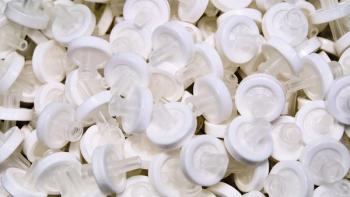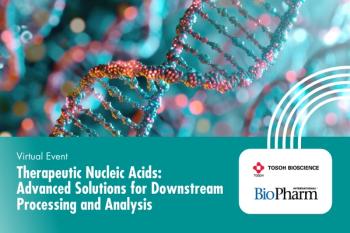
- BioPharm International-04-02-2011
- Volume 2011 Supplement
- Issue 3
Meningitis Vaccine Manufacturing: Fermentation Harvest Procedures Affect Purification
Careful analysis of an unusual precipitate identifies defects.
ABSTRACT
The meningitis vaccine NeisVac-C is a group C meningococcal polysaccharide conjugated to tetanus toxoid. The polysaccharide is recovered from the Neisseria meningitidis cell capsule and is purified by base treatment with subsequent diafiltration to remove hydrolyzed cell impurities. Purified polysaccharide is clear to slightly cloudy. A recent group of successive lots contained large amounts of precipitate that had not been observed in 10 previous years of commercial manufacturing. The precipitate was mostly composed of the sodium salt of palmitic acid (C16:0) with lesser amounts of palmitoleic (C16:1), oleic (C18:1), stearic (C18:0) and myristic (C14:0) sodium salts. The elevated fatty acid levels that formed the precipitate were linked to a damaged pump used during harvest. Replacement of the damaged pump corrected the issue and >15 lots have since been produced without precipitation.
NeisVac-C is a vaccine that prevents the invasive disease caused by Neisseria meningitidis serogroup C. The active ingredient is a polysaccharide–protein conjugate. Each dose contains 10 µg of de-O-acetylated group C meningococcal polysaccharide (GCMP) conjugated to 10-20 µg of tetanus toxoid protein and adsorbed onto 0.5 mg of aluminum as aluminum hydroxide in saline.
Photo courtesy of the authors
The GCMP is isolated from the culture medium of Neisseria meningitidis by microfiltration. The microfiltration permeate is concentrated and diafiltered to remove small soluble fermentation components. The major purification step is a saponification reaction in which the GCMP is refluxed with high concentrations of base for several hours. After diafiltration, the mixture typically appears clear to slightly cloudy. A recent cohort of successive GCMP lots contained a precipitate that had not previously occurred in ten years of commercial manufacturing (see Figure 1). This article describes the problem, the root cause analysis, and the corrective actions.
Figure 1: Visible precipitation during GCMP purification.
Materials and methods
The antigenic component of the vaccine, the de-O-acetylated GCMP, was purified from the culture supernatant of Neisseria meningitidis serogroup C, strain C11. The cells and spent culture medium were circulated through 0.2 µm hollow fiber cartridges using a circumferential piston pump. The permeate from the filtration contained the polysaccharide (see Figure 2).
Figure 2: GCMP purification process.
This filtrate was concentrated and diafiltered across a 300 kilodalton (kDa) nominal molecular weight cutoff (NMWCO) ultrafilter (UF), (Millipore Pellicon 2) (see Figure 2, step 4), which retains the GCMP. The concentrated GCMP was then chemically modified with a saponification reaction to remove acetyl groups (Figure 2, step 5). Base treatment is the major purification step with high temperature incubation for several hours in NaOH.
Deacetylation removed all the acetyl groups from the O-positions and most of the acetyl groups from the N-positions of the GCMP. It also hydrolyzed cell impurities and saponified any fatty acids, which were removed by subsequent diafiltration with water for injection (WFI) across a 50 kDa NMWCO UF (Pellicon 2, Millipore) (see Figure 2, step 6). The GCMP remain in the UF retentate.
The N-acetyl groups are believed to be immunologically important, and were restored in a subsequent chemical reaction (see Figure 2, step 7). After reacetylation, the GCMP was diafiltered and concentrated with a 30 kDa NMWCO UF (Pellicon 2, Millipore) that retain the GCMP. The GCMP was then tested for concentration and purity.
The GCMP content was determined by a colorimetric resorcinol-HCl method (1). This method measured GCMP monomer (sialic acid) using N-acetyl neuraminic acid as a standard.The protein imputity content was determined by the Bradford method (2) using BSA as a standard.
The nucleic acid impurity content was determined by the absorbance at 260 nm, assuming an absorbance of 1 (1-cm light path) for 50 µg/mL of nucleic acid (3).
The white, waxy precipitate was analyzed by Energy dispersive x-ray spectroscopy (EDXS), micro-Fourier transform infrared (FT-IR) spectroscopy, proton nuclear magnetic resonance (NMR), and liquid chromatography-mass spectrometry (LC-MS) to determine its composition. LC-MS analysis of the precipitate was performed on a Waters 2695 HPLC system with a C18 column and a Waters Q-TOf API-US mass spectrometer.
The fatty acids were identified at Microbial ID (MIDI). Samples were saponified in NaOH at elevated temperature and methylated. The fatty acid methyl ester was extracted in an organic solvent prior to injection into the gas chromatograph. Fatty acid identification is based on their retention times compared to a library of standard (4).
Results and discussion
Eight successive purification lots produced in a recent campaign had an atypical appearance (see Figure 1). These lots were cloudy liquids with a white, waxy precipitate in the 50K retentate (see Figure 2, step 6) and/or the 30K retentate (see Figure 2, step 8). The precipitate was identified as mostly the sodium salt of palmitic acid (C16:0). This amount of precipitation had not been noted in past commercial production and its appearance caused cessation of manufacturing while this issue was investigated.
It is believed that most of the GCMP isolated from the fermentation is a lipidated molecule that is able to aggregate either with itself or with other macromolecules such as lipopolysaccharide (5). The aggregates are small enough to pass through the 0.2 µm harvest filters but are retained by the 300 KDa UF (see Figure 2, step 4).
In the deacetylation, many macromolecules are hydrolyzed and the sodium salts of fatty acids are generated. The most common fatty acids in Neisseria are palmitic and palmitoleic acids (see Table I). The fatty acid analysis of our working cell banks was consistent with the literature (6-8) (see Table I) and allowed the authors to conclude that the source of the precipitate was not exogenous but was derived from the cells in our fermentation.
Table I: Fatty acid content (%) of Neisseria meningitidis.
During early development, fatty acid characterization was part of the product impurity profile. Purified GCMP prior to conjugation contained <0.5% (w/w) fatty acids (palmitic, oleic, and 3-OH myristic). After the initial characterization, fatty acids were not routinely analyzed, although residual protein and nucleic acid levels were. These data confirmed that most fatty acids present were palmitic acid, the most prevalent fatty acid in Neisseria. Since the precipitate appeared in the 50K and 30K retentates, it was initially thought that there were flaws in the saponification and diafiltration steps. A significant portion of the root cause investigation examined the purification process, but nothing unusual about the deacetylation or saponification was uncovered. The in-process testing for residual protein and nucleic acid gave acceptable and typical results (see Table II). Since no protein or nucleic acids could be detected, and purification of GCMP was achieved, abnormalities in GCMP purification were ruled out as a root cause and the focus of the investigation shifted to the fermentation and harvest steps.
Figure 3: Damage to the harvest pump mating surfaces.
Many of the fermentation inputs can affect cell metabolism and as a consequence, GCMP yield. Prior to the appearance of precipitation, the authors had seen increasing GCMP yields for several months. It was hypothesized that fermentation medium or operational parameters had changed, increasing GCMP yield in the form of lipidated-GCMP and therefore overwhelming the purification system. Several test runs were made to alter the fermentation process and reduce the GCMP yield, but had no apparent effect on the precipitation problem.
Table II: In-Process testing of 30K retentate for purity of the precipitation lots: residual protein and nucleic acid
The GCMP harvest was more closely examined. This process involved circulating the contents of the fermentation vessel through 0.2 µm hollow fiber cartridges using a circumferential piston pump. This pump is designed with moving part tolerances tighter than most similarly-sized rotary lobe pumps. Since the product is in the filter permeate, the fermentation medium is continuously circulated until the retained volume was low. We estimate that each cell passes through the harvest pump ~300 times. Upon examination, the harvest pump showed damage on mating surfaces in the lobes and rotor housing (see Figure 3). This damage had occurred when a catastrophic event scored these surfaces, rather than being the result of normal wear and tear. The pump continued to deliver expected volumes and pressures but the authors decided to replace it with an identical pump. The abnormal precipitation in the downstream process immediately ceased.
Figure 4: Fatty acid/GCMP % (w/w) in fermentation lots.
The authors concluded that the harvest pump, while operational, was damaged in such a way that it was also acting as a cell disruptor. Not only was more lipidated-GCMP sheared from the cell capsule, but the cell membranes were disrupted, forming fragments small enough to pass though the 0.2 µm harvest filters (see Figure 2, steps 2 and 3), but large enough to be retained in the initial GCMP capture step (see Figure 2, step 4). Fatty acids in this material would be saponified in the deacetylation step (see Figure 2, step 5). If the sodium salts were soluble, they would be removed from the system during diafiltration. If they were not soluble, such as the sodium salt of palmitic acid, they would precipitate during this process. The ability of the damaged pump to mechanically extract fatty acids from the cells must have been increasing for several months before a critical point was reached where the amount or type entering the downstream process overwhelmed its ability to remove it.
Table III: Concentration of palmitic acid entering the saponification step.
Analysis of the 300K retentates (see Figure 2, step 4) by GC showed a general trend of lower total fatty acid/GCMP ratios in lots that did not generate precipitation downstream (see Figure 4). No specific level could predict if a lot would precipitate, but 30-40 % (w/w), could be used as an alert level. This interpretation was enhanced when the specific concentration of palmitic acid entering the deacetylation/saponification process was examined. Deacetylations with palmitic acid >0.7 g/l were likely to precipitate (see Table III).
Table IV: Fatty acid composition (%) at different stages of processing in lots that precipitated fatty acid.
The 300K retentate was the starting material for the saponification reaction. There is a mixture of saturated (palmitic, myristic) and unsaturated (palmitoleic, oleic) fatty acids in this retentate (see Table IV). The precipitate in both the 50K and 30K retentates was composed primarily of sodium palmitate. This contrast is explained by the differences in solubility of the fatty acids. As reported by McBain et al9, the sodium salts of unsaturated fatty acids were more soluble than the sodium salts of saturated fatty acids. Another factor that affects the fatty acid composition of the precipitate is the length of the fatty acid hydrocarbon chain: the longer the hydrocarbon chain, the less soluble the fatty acid was in water. Sodium oleate and sodium laurate are soluble in water at temperatures under 45°C. Sodium myristate, palmitate, and stearate have much lower solubility at the same temperature. This property may be the reason for the oleic acid to be the more abundant unsaturated fatty acid in the precipitate, despite the fact that palmitoleic acid is one of the most abundant fatty acid in the 300K retentate.
Since an increase in fatty acid concentration in the 300K retentate was associated with the use of a damaged pump, it is reasonable to conclude that the damaged pump affected the integrity of the cells by increasing shear forces due to metal-to-metal contact. The issue described here highlights the importance of preventive maintenance. The pump had been in place for several years and appeared to work properly, in that it maintained normal flow rates and pressures during operation. Maintenance technicians performed preventive maintenance at routine intervals, focusing on electric current demand and replacing hydraulic oil in the gear case. The pump head was not routinely examined. Given what was learned about the sensitivity of bacterial cells to shear, the authors now visually inspect the pump more often and replace it at any sign of damage.
Acknowledgments
The authors wish to thank Liqiong Fang, PhD, research scientist, Kirk Ashland, PhD, senior research scientist, Frank Hua, PhD, research scientist, and Catherine Quinn, research associate, all at Baxter Healthcare, Round Lake. IL, who provided critical analyses in support of this study.
AMY ROBINSON, PHD is a senior manager, SHWU-MAAN LEE,* PHD is a technical director, BOB KRUSE, PHD is a research scientist, and PEIFENG HU, PHD is a principal scientist, all at Baxter Healthcare, 8000 Virginia Manor Road, Suite 140. Beltsville, MD 20705.
References
1. L. Svennerholm, Biochimica et Biophysica Acta, 24, 604-11 (1957).
2. M. Bradford, Anal. Biochem. 72, 248–54 (1976).
3. C.E. Frasch, Production and control of Neisseria meningitidis vaccine, Adv Biotechnol Processes. 13, 123–145 (1990).
4. Microbial Identification by Gas Chromatographic Analysis of Fatty Acid Methyl Esters (GC-FAME), MIDI Technical note #101.
5. E.C. Gotschlich, et. al., J. Biol. Chem. 256, 8915–8921 (1981).
6. V.J. Lewis, R.E. Weaver, and D.G. Hollis, J. Bacteriol. 96, 1–5 (1968).
7. C.W. Moss, et. al., J. Bacteriol. 104, 63–68 (1970).
8. M.M. Rahman, V.S.K. Kolli, C.M. Kahler, G. Shih, D.S. Stephens, and R.W. Carlson, Microbiol. 146, 1901–1911 (2000).
9. J.W. McBain, and W.C. Sierichs, J. Amer. Oil Chemist's Soc. 25, 221–225 (1948).
Articles in this issue
over 14 years ago
Innovation and the Art of Downstream Processingover 14 years ago
BioPharm International, April 2011 Supplement (PDF)Newsletter
Stay at the forefront of biopharmaceutical innovation—subscribe to BioPharm International for expert insights on drug development, manufacturing, compliance, and more.




